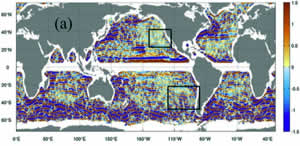
Global east-west ocean velocities (cm/s) Image: Maximenko et. al
It's amazing that nobody has spotted it before. Superimposed on every ocean on the planet there is a striped pattern of currents. Yet what causes them is a mystery.
Between 1992 and 2003, Peter Niiler of the Scripps Institution of Oceanography in San Diego, California, and colleagues collected data from more than 10,000 drifting ocean buoys, which they tracked with satellites. As expected, the buoys' movements were influenced mainly by known global currents, which are driven by wind and by differences in the temperature and salinity of seawater.
But when the team analysed the data, it emerged that something else had been subtly influencing the buoys' paths. It turned out that there were alternating strips of water running eastward or westward, a bit like parallel moving sidewalks. Niiler recalls his reaction: "My God, we've never seen these before."
Satellite measurements showed that the interfaces between adjacent currents were alternately associated with slight peaks and troughs in sea level. When the team looked at this variation globally, they found that the 150-kilometre-wide bands covered pretty much every ocean (see Map).
To confirm that the currents were real, the team set out to measure them directly in two regions in the eastern Pacific. "Their existence is so surprising that we had to prove first that they are not an artefact of satellite data," says Nikolai Maximenko of the University of Hawaii. Sure enough, they recorded currents flowing in opposite directions at around 40 metres per hour (Geophysical Research Letters, DOI: 10.1029/2008GL033267). This is slower than most previously known ocean currents, which may explain why the striped flows have remained undiscovered until now. "Only a very lazy canoeist would notice the effect," says Maximenko.
The flows extend right down to the ocean floor, and the boundaries between currents are alternately associated with peaks and troughs in temperature as well as sea level. This suggests that they influence processes such as nutrient and energy flow around the oceans, but this has yet to be proven, says Niiler.
What causes the striped flows remains a puzzle. "They are a fascinating new aspect to the ocean's circulation, but the jury is still out on the mechanisms leading to their formation," says Geoff Vallis of the Geophysical Fluid Dynamics Laboratory at Princeton University.
He points out that similar patterns exist in atmospheric flows on other planets, for example, Jupiter. Whether similar effects are at play here is unclear, he says.
